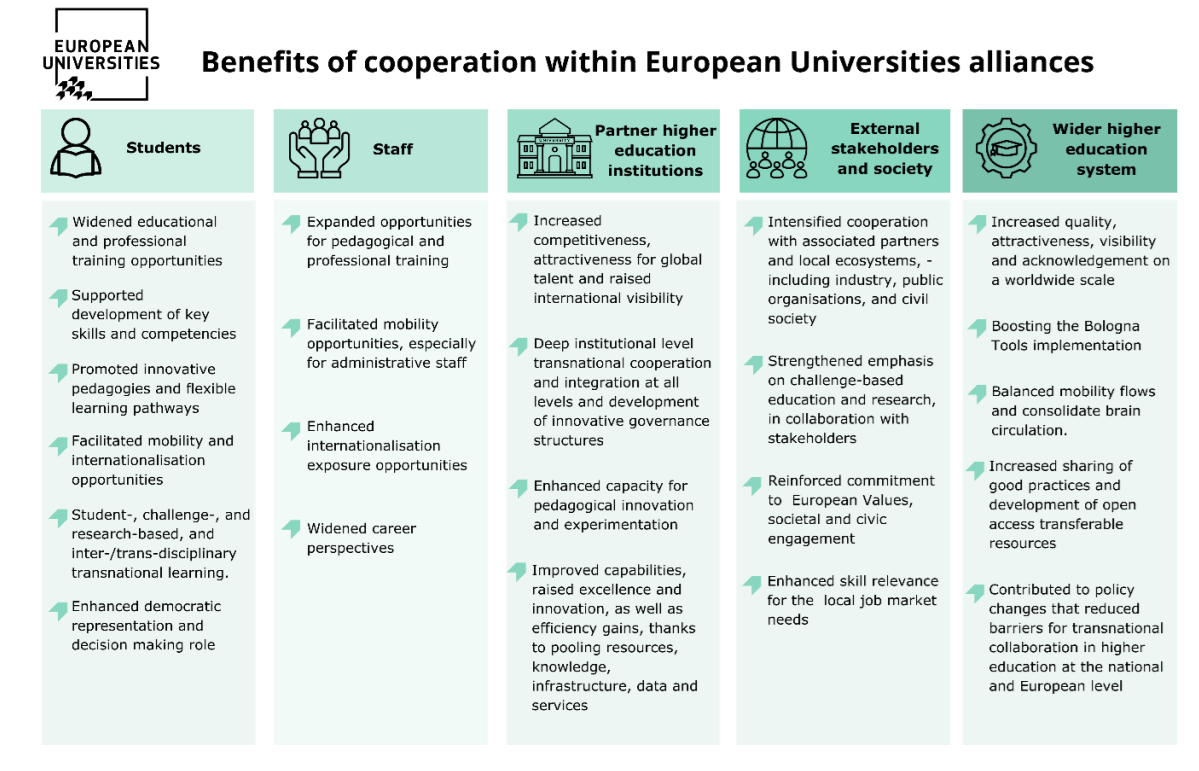A large scale initiative
Currently, partner universities in European Universities alliances collectively involve over 11 million students, accounting for approximately half of all students in Europe. There are 65 European Universities alliances present in more than 35 countries, including all EU countries.
Topics covered by these alliances are very diverse. The common thread is their connection to global interests. Key topic areas include:
- Sustainability and environment
- Digital transformation
- Health and well-being
- Social sciences and humanities
- Economic development and entrepreneurship
- Arts
- Cultural heritage and identity
- Gender equality and social inclusion
- Migration and human rights
- Urban and regional development
- Engineering
- Mathematics and technology
- Coastal and blue economy
- Space
The main strengths of the initiative are inclusivity and geographical balance. At their core, alliances bring Europeans closer together, fostering a spirit of collaboration and peace in Europe.
Added value extends far beyond the alliances
European Universities alliances benefit students, university staff, partner higher education institutions, external stakeholders, society, and the wider education system, as presented below:
The established alliances have collectively launched more than 600 joint study programmes and courses at all levels thus far, including around 160 joint degree programmes. They have also launched over 430 short courses leading to micro-credentials.
Although challenges remain and enhanced efforts are needed to achieve 50% of mobility targets, the alliances have already increased intra-alliance students’ mobility by 400% and reported a 200% increase in staff mobility over the first three years of operation (in relative terms). Furthermore, nearly 75% of the alliances have established or are in the process of establishing departments, centres, living labs, or other structures and initiatives to support citizen engagement.
Game changer for higher education institutions
HEI consider that their participation boosted their international visibility, attractiveness, and competitiveness. Some of the most notable benefits include higher international ranking positions, reinforced joint publications, stronger appeal for international talent through transnational education opportunities and joint degrees, and new collaborations. Together, these improvements also contribute to the global visibility and reputation of EU higher education.
The alliances have also established innovative and inclusive governance structures, showcasing their commitment to fostering long-term, sustainable cooperation that goes beyond project-based approaches. Besides 14 legal entities and long-term strategies, other joint initiatives include inter-university campuses with joint course catalogues, functional digital campuses, learning platforms for hosting joint learning offers and activities, shared student and research services, equipment, and infrastructures.
The alliances have also developed joint quality assurance strategies and set up joint services, governance and management tools, all of which further emphasise their commitment to the excellence of co-created educational activities.
Challenge- and research-based as well as inter-/transdisciplinary translational learning is the leading concept behind joint academic initiatives, which are further reinforced through student-centred flexible learning pathways and innovative pedagogies. This approach was central to the development of 528 short courses featuring challenge-based learning and 195 courses launched in cooperation with external stakeholders.
To bring the common vision to life, the alliances combined complementary strengths which were not readily available at single partner institutions. Pooling expertise, knowledge, resources, and setting up joint governance structures within the alliances unlocked a new dimension of growth and development – followed by invaluable outcomes that benefit all involved parties.
Towards a common European degree
One of the pivotal advancements within the European Universities initiative is the development of a European degree label collaboratively awarded by multiple institutions across different countries. Between 2022 and 2024, 21 alliances engaged in Erasmus+ pilot projects to assess the potential of this label, identify existing obstacles, and experiment with innovative joint programs spanning various academic levels: bachelor’s, master’s, and doctorate. These concerted efforts culminated in March 2024 with the adoption of the European Degree Package – a comprehensive roadmap encompassing policy recommendations, a standardised label model, and technical support mechanisms for EU Member States.
Key drivers for European level policy developments
The alliances have made a transformational impact at the EU level. They have advanced European integration and cohesion, increased social engagement, and made higher education more responsive and relevant to labour market needs while promoting a common identity and common values, including academic values. Furthermore, the alliances drove policy progress at EU level, acting as pioneers in shaping the future of European higher education.
Stakeholders consider the initiative as a significant driver for the Bologna Process through mutual recognition of qualifications, the removal of barriers to mobility, and the establishment of joint programmes. The alliances are also boosting the implementation of the Bologna tools at the national level by removing legal barriers to the accreditation of joint programmes and the delivery of joint degrees, as well as the recognition of innovative mobility formats in several Member States
According to students’ organisations, the initiative is also fostering the representation of students within the alliances’ governance, as well as promoting inclusivity and diversity. Indeed, students are involved in the governance of 95% of alliances, with 63% of them granting full voting rights.
Students are also cooperating across the alliances. Several European Universities alliances have launched a grassroots initiative to empower students and give them influence over the future of Europe. The European Student Assembly (ESA) is a direct outcome of this initiative.
Drivers for accelerating national policy development and the European higher education system
The alliances demonstrated transformative potential at the national level, enhancing the quality, attractiveness, and competitiveness of national higher education systems. More specifically, the work of the alliances prompted numerous Member States to adapt legislation and policies to remove barriers, allowing seamless transnational cooperation in higher education. Reflecting on this development, higher education institutions reported that the alliance context helped them add value to national-level discussions on educational policy developments. Moreover, national HEIs participating in alliances form an important network capable of driving transformation in the whole sector, enriching study offers across their territories, and possibly even contributing to a cohesive revival of EU regions.
The alliances are acting as test beds and laboratories for the universities of the future, thus benefiting the entire higher education sector by pioneering new approaches and methods for systemic institutional-level cooperation across all universities’ missions, as well as promoting innovative pedagogies, mobility models, and joint educational offerings.
The alliances actively collaborated with institutions beyond their partnership in the broader higher education systems at the national level, helping to implement good practices and transfer their outcomes. Almost 90% of the alliances are actively engaged in sharing good practices with other university networks, as well as organising outreach and dissemination events. Moreover, more than two thirds of the alliances are actively publishing open-source educational and management materials. Alliances have also united for the FOREU4ALL project, acting as a Community of Practice.
A key player of local ecosystems
One of the unique characteristics of European Universities alliances is the development of structured, long-term, multifaceted, engaged, and inclusive cooperation with their over 2200 associated partners within their local ecosystems. This leads to strengthened links between academia, business, and society, which collectively translate to high societal impact. The associated partners span across 43 countries in the EU and beyond.
The alliances contribute to local and regional development by offering services to the society that stimulate economic activity and cohesion as well as civic and cultural activities, in turn positioning communities as more attractive places to live and socialise. Internal stakeholders are involved in the governance structures of about 55% of the alliances. The involvement of associated partners from local and regional businesses and civil society is instrumental in driving innovation in pedagogies and shaping curricula that address labour market needs and support green and digital transitions.
Political support at the highest level
This momentum aligns with the broader vision promoted by the European Union, positioning European Universities as strategic levers for transforming higher education. The initiative receives robust support from European institutions and political figures such as Ursula von der Leyen, Enrico Letta, and Mario Draghi, who advocate for a significant increase in funding. The goal is to ensure long-term establishment of these alliances, enabling them to continue their leading role in building a more integrated, innovative, and attractive European Education Area.
Progress in the face of challenges
Despite clear outcomes and value on both national and international levels, some challenges are still restricting the transformative potential of European Universities alliances. The main challenges concern legal and administrative barriers, which hamper the development of joint educational activities, pose additional difficulties in the onboarding of the broader community, slow down the achievement of the 50% mobility target and the short-term versus the long-term funding vision, and restrict the interoperability of IT systems. Those challenges are relevant for almost all HEIs and need to be addressed both at the national and EU levels.




